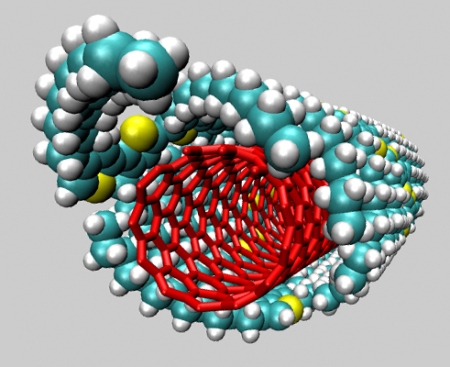During the production of carbon nanotubes, tubes that are useful for solar cell applications get mixed with tubes that are useful for battery applications, resulting in a nanotube powder that cannot be used for any commercial purpose.
 A computer-generated cross section of the polymer-coated carbon nanotube. The polymer shell (blue) wraps around a semiconducting single-walled carbon nanotube (red) (Credit: Francois Gygi and Giulia Galli / UC-Davis)
A computer-generated cross section of the polymer-coated carbon nanotube. The polymer shell (blue) wraps around a semiconducting single-walled carbon nanotube (red) (Credit: Francois Gygi and Giulia Galli / UC-Davis)
Stanford University Professor, Zhenan Bao, and her team of researchers at the Samsung Advanced Institute of Technology and University of California-Davis have developed a process for carefully separating semiconducting single-walled carbon nanotubes from a mixture that also contains conducting carbon nanotubes.
With this innovative method, the semiconducting nanotubes can now be used for the advancement of flexible transistors, stretchable electronics, bendable display screens and printed circuits on plastics, as well as to fill the voids in solar cells.
The research team utilizes a polymer that carefully separates the mixture by encapsulating the semiconducting nanotubes but not the conducting nanotubes. The polymer is mixed with carbon nanotubes commercially available, in a solvent resulting in differentiation between conducting and semiconducting tubes. Polymers have already been utilized in the sorting of conducting nanotubes and semiconducting nanotubes, but they need an extensive removal processes to reinstate the nanotube’s conductivity.
The polymer used in the Bao’s method eliminates the tedious removal process, resulting in a final product comprising a polymer ink and the semiconducting nanotube. The polymer ink can be utilized in the production of printable electronics. The research team studied around 200 single nanotubes to prove that the polymer material encapsulates only the semiconducting tubes. To understand the mechanism of polymer wrapping, the team has reproduced the geometry of the polymer-coated carbon nanotube.